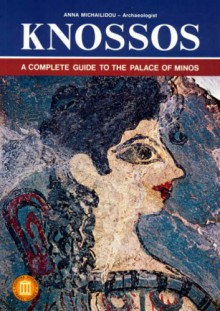
This is a book that I picked up at one of the gift shops that dot the road to the entrance of Knossos. In fact, when you wonder through Greece you see lots of these stalls with a multitude of books (in a multitude of languages) in the myriad archaeological sites scattered about the country, however the books that tend to dominate the stalls outside of the ancient sites tend to relate to those sites. Mind you, I discovered that there are a number of the books available in Italy as well, but once again they tend to relate to the specific city or site that the stall is in or near. I did consider picking up a book about Florence, until I discovered that it really only contained touristy stuff rather that stuff that I really wanted to know about Florence (that I don't know already).
This book has a small first part which looks at the myths and history that relate to the ruins at Knossos, and then a majority of the book describes a tour around the ruins. It is probably something that you can read through as you explore the ruins, though if you are going to do that then you are going to need to spend much longer than the three hours that I spent there with my brother. The reason that I say that is because the ruins are massive, and following the trail that the book sets out can be a little confusing if you are not there (and even though I am a little familiar with the site, having been there, it was still a little confusing following along in this book).
Knossos is located about half-an-hour by bus from the Cretan capital of Heracleum. Mind you, you need to get one bus from the airport to the city centre, and then another bus to the ruins (though the buses do leave quite regularly). As can be expected with Greek cities though, the roads are quite narrow and clogged with cars, and the locals view road rules as recommendations. I was amazed though that the bus driver was able to get from the centre of Heracleum to Knosses without doing major damage to his bus, or any of the other vehicles on the road. Oh, and you can also do it as a day trip from Athens. We flew out in the morning, spent the day in Crete, and flew back in the afternoon. After visiting the ruins we even had time to wonder around Heraculum (though watch out for the cabbies because they do rip you off).

As for the myths, I should make mention of them because that is one of the areas that interests me. The two main myths regarding Crete involve Icarus and Daedelus. The story goes that king of Crete (Minos, who is said to be the child of Zeus, but that is not surprising considering he was a strong king ruling a powerful empire, so they are likely to make up such stories) had sent his son to Athens where he won all of the games at a competition. In a fit of jealousy the Athenians killed the king's son and in response Minos invaded Athens, subjugated them, and forced them to send tribute in the form of young men and women, to be sacrificed to the minotaur who lived in the labyrinth. Theseus, the Athenian Crown Prince, then went with one of the groups, seduced Ariadne, the daughter of Minos, and got her to help him escape the labyrinth (using a ball of twine) after killing the minotaur. When this was discovered, the designer of the labyrinth (Daedelus) and his son (Icarus) then decided to flee, and built wings to do so.
Now, my interpretation of the myth is that they are likely embellished stories based upon facts. The labyrinth most likely existed, but the minotaur did not, with the exception that it was a pretty nasty bull that was thrown into the labyrinth and starved. As you wonder around Knossos you will notice that there are lots of images of bulls as well as horns that have been carved out of stone (as the pictures below show).


The same goes with the story of Daedelus and Icarus. They are probably real people, but the story of them flying is a likely embellishment (and most likely fled Crete by a very fast ship on which Icarus likely died during the voyage, most likely due to his own stupidity). The story does continue in that Minos pursued Daedelus to Sicily where he was killed, and the Minoan fleet was destroyed on the way back by a violent storm (which could have been the volcanic eruption from Thera).
As others accept, there is a lot of truth in myth, but what one needs to do is to be able to sift through the stories and strip away a number of the embellishments. A great hero, or even a great king, is likely to be referred to as the child of a God, due to his almost heroic powers, in the same way that it is possible that the stories about Zeus impregnating queens could easily have been excuses to cover up marital infidelity (though I do wonder if they really would have got away with that, and whether the men were that gullible to actually believe it, but then again in a very religious culture people can be quite gullible).


 Log in with Facebook
Log in with Facebook 








